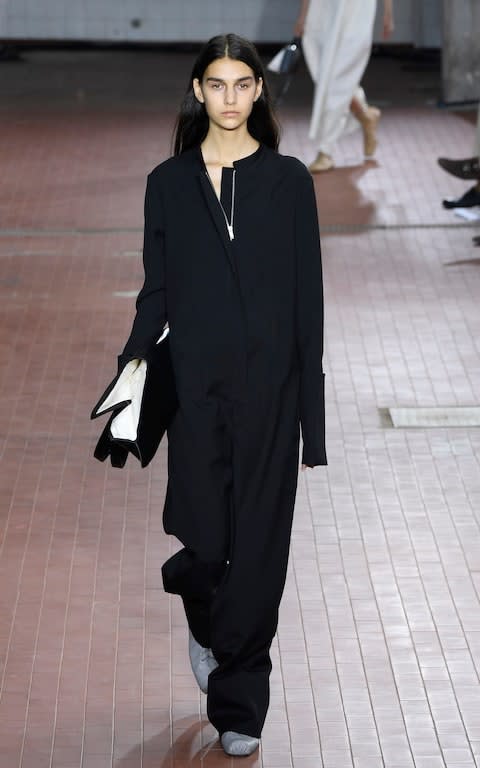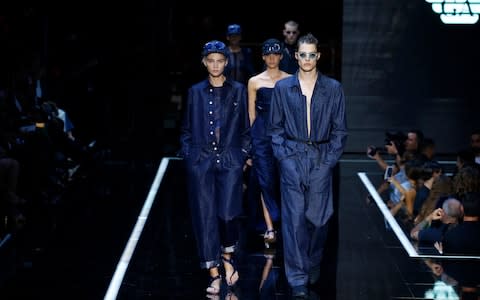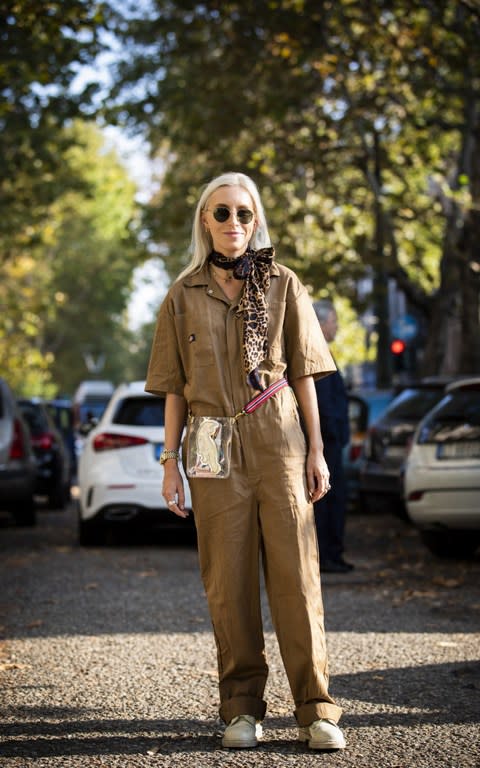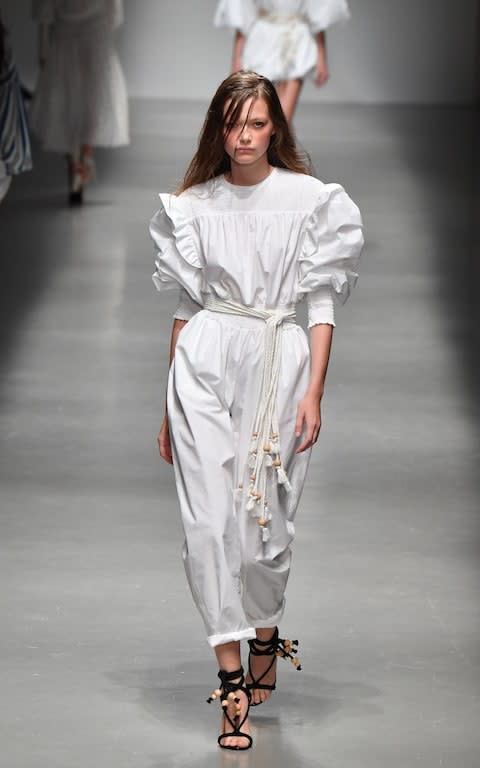Bringing back the boiler suit: how Milan ditched the glitz for cool utility
The most unexpected success story in Milan was the (re)emergence of the boiler suit – the hardier, workhorse, cousin of the jumpsuit. Think loose, scrunch up the arms, roll up the ankles, unload the dishwasher chic. This is all – thankfully – about keen practicality and clothes in which we can get life done – run around, bend down, reach up, stay warm, stay covered, without losing our sense of self (even Versace had trainers on its catwalk).
You’d think in 2018, these basic considerations would be a given. Not in Milan, where stilettos, sequins and the traditional glitz of 20th-century luxury are staples of most designers. At Jil Sander, where its three seasons-in husband and wife team Luke and Lucie Meier are getting into a very good groove, it was roomy and made for living in.

They took their starting points as “the idea of uniform and making real clothes for today”. As well as hardy-looking suits, see their giant squidgy bags, which could double up as a pillow as well as being able to lug around all your daily ephemera.
Ian Griffiths, Max Mara’s down-to-earth creative director embraced the new feminist readings of the classical world (cues taken from Madeline Miller’s Circe, Pat Barker’s The Silence of the Girls, Margaret Atwood’s Penelopiad and the recent release of Emily Wilson’s translation of The Odyssey, the first by a woman) exploring the idea of clothing as armour. And what does a modern Amazon wear? With a nod to its ancient warrior origins – a one-shouldered boiler suit, with a roomy satchel slung across – uninhibited (unlike, say, those old-fashioned heavy totes that require being lugged around in-elbow).
Giorgio Armani, that master of languid, easy tailoring, struck gold with a button-through shimmering take in his Emporio Armani collection – worn, note, with a serviceable flat sandal. And if you still need a soup?on of frill, see Philosophy di Lorenzo Serafini, where a happy medium was reached with pouffy-shouldered perfection.

You need not, of course, wait until next spring to embrace your inner Rosie the Riveter. M C Overalls (a classic uniform brand resurrected by music industry marketeer James Scroggs last year) has quietly made strides since its relaunch and recently opened a store on Brewer Street, Soho.
Stylist and self-confessed boiler suit obsessive Natalie Hartley has three pairs – in navy, black and cream. “They’re the best pieces I’ve ever bought. It’s my daily uniform – practical but still stylish. I wear mine loose so I can move around easily ... and they’re machine washable. I dress them up for meetings with smart boots and layer with a roll neck in winter. You can do so many things with them, that you don’t actually need anything else in your wardrobe. I’m all about effortless dressing, these don’t need much else, as they’re statement and versatile enough as it is,” she raves. The collection is unisex and comes across a wide range of sizes, and even better, is keenly priced (£135 for a cotton suit).
Polycotton Collared Zip Overall Pink, £135, M C Overalls
But there are more, outside the shows – in New York, London and Milan, those prancing peacocks, more used to flapping about in coloured feathers to get the attention of the snappers, had toned it down, industrial-looking boiler suits abound. Gigi Hadid and Kylie Jenner are fans – this is covered-up cool, not flashy, bottom-showing stuff. See also Net-a-Porter’s Lisa Aiken and Cate Blanchett – often spotted in an all-in-one.
Last time the boiler suit had a serious moment was the Seventies – where hardline feminists adopted it to their cause, eschewing make-up and any other feminine fripperies (less Charlie’s Angels, more Lynne Franks). The revamp is being worn with a clumpy sandal or a heel, or a trainer or a boot. The point is that it’s completely versatile. Be comfy yes, but be comfy your way. Glamour isn’t the antithesis to a boiler suit either – do your hair, pop on a blazer and you’re in a board meeting or out for dinner. And frankly anything can be jazzed up with a giant earring.

The concept of power dressing – see Melania-esque tropes of tight-dress-vamp-heels – is shifting and being questioned, and ultimately diversifying. What strength is there in an outfit so constricting that you need to wear a pair of stringent cycling shorts as underwear? What is powerful about not being able to move nimbly in a pair of vertiginous heels? That isn’t power, that’s just patriarchal-pleasing discomfort.
A resurgence of #MeToo came this week across social media, the new water cooler – as women – including Julianne Moore, Reese Witherspoon, Kerry Washington and Tracee Ellis Ross – posted a “serious” picture of themselves, wearing black in support of Christine Blasey Ford, who has accused US Supreme Court nominee Brett Kavanaugh of sexual assault. Which shows that clothes remain a live issue in the search for empowerment – especially on Instagram – sartorial impact is key.

Fashion power dressing is no longer about honed silhouettes and single items. The “power” necklace, the statement bag or shoe … what statement is that exactly? I’m stronger than you because I’ve spent £1,000 on a handbag?
Instead it's about simplicity, a blacking out of mixed-signals, a way of transmitting an unfettered message in one head to toe look. Forget being swathed in reams of uncompromising fabric, high necks and ruffle-covered wrists, the new utility is here to make our world more of a “get dressed in two minutes and get on with it” sort of a place.
If you’re still not convinced – you might live for dresses, as with one pull over the head you’re pretty much done. The boiler suit does the same thing, but won’t expose your knickers with an errant gust of wind. I don’t know about you, but for me, that’s all the power I need.